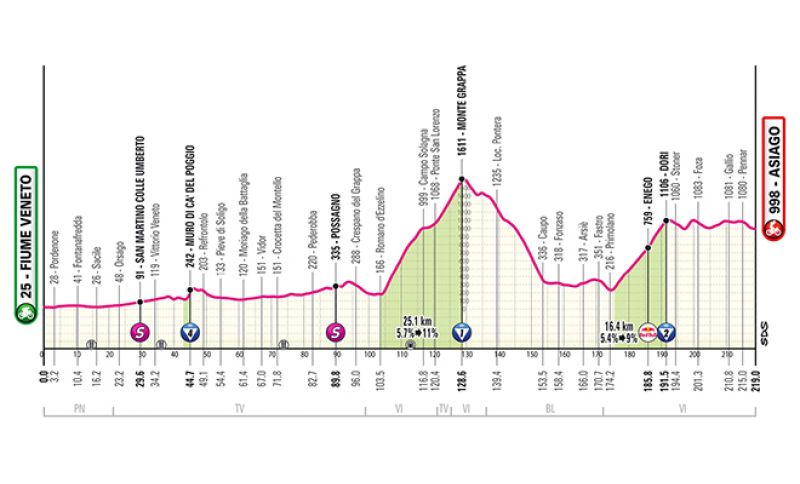

The Giro d'Italia reaches its fifteenth stage and changes rhythm: the 219 km Fiume Veneto - Asiago is indeed the first mountain stage, a sort of prologue to the extremely challenging final week.
to follow the live coverage of the entire stage starting at 11:25 CLICK HERE
The first part of today's stage is flat until the outskirts of Bassano del Grappa, followed by two long climbs leading to the Asiago Plateau. The Muro di Cà del Poggio is scaled first before crossing the Piave and reaching Possagno and Romano da Ezzelino, where the 25 km climb along Strada Cadorna begins to the top of Monte Grappa (25.1 km at 5.7%). A long and challenging descent to Fonzaso and Arsié, where, after passing the Primolano Scales (downhill), the "Enego climb" is tackled, leading to the GPM at Dori about 20 km from the finish.
The last 20 km are very undulating, and the final 5, after Gallio, are even slightly downhill until 900 meters from the finish line.
THE TERRITORY. The decisive week of the Giro begins from Fiume Veneto. From today onwards, there's no more hiding, but that's the riders' problem. For everyone else, the fifteenth stage route will be a concentration of emotions, immersions in history, art, and the excellences of the Bel Paese.
Fiume Veneto is certainly off the major tourist routes, but it has all the credentials to fascinate visitors. Its historical and natural heritage is particularly significant. Fiume Piccolo is characterized by 17th-18th century houses with colorful facades that earned it the nickname "little Murano". The Mortol River Park, located in the city center, is a green oasis along the river's bends, now transformed into a recreational area and meeting point.
Passing Pordenone, designated as the Italian Capital of Culture 2027, you arrive in Sacile: defined as the "Garden of the Serenissima" for its Venetian atmospheres and elegant palaces reflecting in the Livenza waters. Among the numerous 16th-century palaces that make Sacile the Renaissance city par excellence are the Municipal Loggia and Palazzo Ragazzoni Flangini Billia.
In Vittorio Veneto, you enter the wonderful world of Prosecco Hills, included in the UNESCO World Heritage Site for their beauty. Nothing prevents, however, honoring the palate with one of the most famous Italian wine excellences worldwide.
The feast of vineyards and cellars continues to Possagno where everything speaks of Antonio Canova, the leading exponent of Neoclassicism who was born here in 1757 and then gifted the world with his extraordinary sculptures. The town is dominated by the white mass of the Canovian Temple, designed by the artist himself, inspired by the Pantheon. Visits to the Gypsotheca Antonio Canova Museum and Canova's Birthplace are a must, where you can admire the artist's paintings and engravings, work tools, clothes, and memorabilia.
Bassano del Grappa first conquers with the famous Alpini Bridge, built on Palladio's design and recently restored to its original splendor. During every walk in the town center, you must pass here, crossing the Piave while walking on a monument that is part of every Italian's memory. Visits to Palazzo Sturm, home of the Ceramics Museum, the Remondini Printing Museum, and the Grappa Museum then tell the story and versatile industriousness of Bassano's inhabitants. The season is perfect for tasting the delicate Bassano White Asparagus DOP and the DOP Cherries of nearby Marostica.
The climb to Monte Grappa's peak leads to one of the most dramatic pages of World War I: a stop at the military memorial near the summit is poignant and dutiful.
Although also a theater of terrible Great War battles, Asiago offers the pleasure of finding oneself in the heart of a vast plateau at about a thousand meters above sea level. The villages dotting the Plateau of the Seven Municipalities (Conco, Enego, Foza, Gallio, Lusiana, Roana, and Rotzo, besides Asiago itself) should be visited one by one. Here lived the mysterious Cimbri people, so the place was welcoming since ancient times. Who knows if they invented Asiago DOP, one of the most famous and exported Italian cheeses, produced in the area's mountain huts and dairies?

Se sei giá nostro utente esegui il login altrimenti registrati.